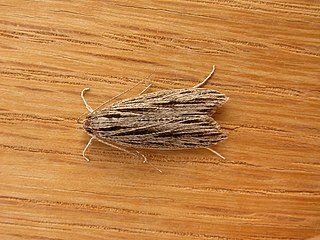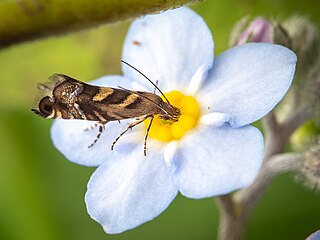
Leistarcha scitissimella is a moth of the family Xyloryctidae. It is found in Australia, where it has been recorded from the Australian Capital Territory, New South Wales and Queensland.

Izatha apodoxa is a moth of the family Oecophoridae. It is endemic to New Zealand, where it is known from scattered localities in the southern North Island. This species is variable in appearance and comes in two forms, a grey form and a black and white form. In the grey form it is very similar in appearance to I. notodoxa and in the black and white form to I. katadiktya. At present the larvae and biology of this species is unknown.

Glyphipterix tungella is a species of sedge moth in the genus Glyphipterix. It is endemic to New Zealand and is found throughout the country. Larvae mine the leaves of small sedges. Adults of this species are day flying and inhabit sheltered scrub or grassy areas and forest clearings.

Ichneutica steropastis, or the flax notcher moth, is a species of moth in the family Noctuidae. It is endemic to New Zealand and can be found throughout the country from the Three Kings Islands to Stewart Island as well as in the Chatham Islands. The larvae of this species feed on a variety of native and introduced plants however the New Zealand flax is one of the more well known host plants for the larvae of this moth. The larvae are nocturnal, hiding away in the base of the plants and coming out to feed at night. They create a distinctive notch in the leaf when they feed. The adults of this species are on the wing from October to March. Although adult specimens of I. steropastis are relatively easy to recognise they might possibly be confused with I. inscripta, I. theobroma or with darker forms of I. arotis. However I. steropastis can be distinguished as it has a long dark basal forewing streak that these three species lack.
Hypatima isoptila is a moth in the family Gelechiidae. It was described by Edward Meyrick in 1913. It is found in Sri Lanka.
Ardozyga thyrsoptera is a species of moth in the family Gelechiidae. It was described by Edward Meyrick in 1904. It is found in Australia, where it has been recorded from Queensland.
Exoteleia ithycosma is a moth of the family Gelechiidae. It is found in Guyana.
Polyhymno oxystola is a moth of the family Gelechiidae. It was described by Edward Meyrick in 1913. It is found in Mpumalanga, South Africa.
Polyhymno pausimacha is a moth of the family Gelechiidae. It was described by Edward Meyrick in 1909. It is found in Namibia and South Africa.
Antaeotricha astynoma is a species of moth of the family Depressariidae. It is found in Guyana.
Stenoma nebrita is a moth of the family Depressariidae. It is found in Panama, Costa Rica and Guyana.
Antaeotricha thylacosaris is a species of moth of the family Depressariidae. It is found in Guyana, French Guiana and Brazil.
Antaeotricha tribomias is a species of moth of the family Depressariidae. It is found in Guyana.
Cerconota languescens is a moth of the family Depressariidae. It is found in Guyana, French Guiana and Brazil.
Eclecta is a monotypic moth genus in the family Depressariidae. Its only species, Eclecta aurorella, has been found in the Australian state of New South Wales. Both the genus and species were first described by Edward Meyrick in 1883.
Hypercallia chionopis is a moth in the family Depressariidae. It was described by Edward Meyrick in 1916. It is found in French Guiana.
Hypercallia cyathopa is a moth in the family Depressariidae. It was described by Edward Meyrick in 1913. It is found in Colombia.
Antaeotricha camarina is a moth in the family Depressariidae. It was described by Edward Meyrick in 1915. It is found in Guyana.
Antaeotricha lecithaula is a species of moth in the family Depressariidae. It was described by Edward Meyrick in 1914. It is found in Guyana.

Ichneutica paracausta is a moth of the family Noctuidae. This species is endemic to New Zealand. It is found locally in the central North Island, is widespread in the South Island and can also be found in Stewart Island. I. paracausta is variable in colour, but as it has a distinctive black streak on its forewing as well as a wing pattern that is characteristic, I. paracausta is unlikely to be confused with other species. It is present on the North Island volcanic plateau as well as Little Bush Reserve in Hawkes Bay in the North Island as well as in tussock grassland, alpine and subalpine shrubland and in alpine forest. Larvae have been recorded as feeding on grasses, a pupa has been found in a cocoon under the bark of a tree and adult moths are on the wing from October to January.




